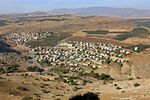Khirbat al-Wa'ra al-Sawda'
Arab villages depopulated during the 1948 Arab–Israeli WarDistrict of Tiberias

Khirbat al-Wa'ra al-Sawda' (Arabic: خربة الوعرة السوداء) was a Palestinian Arab village in the Tiberias Subdistrict. In 1945, the village had a population of 1,870 Arabs. It was depopulated during the 1947–1948 Civil War in Mandatory Palestine on April 18, 1948. It was located 7.5 km northeast of Tiberias. Some of the villagers fled to Syria while others migrated to the central Galilee.
Excerpt from the Wikipedia article Khirbat al-Wa'ra al-Sawda' (License: CC BY-SA 3.0, Authors, Images).Khirbat al-Wa'ra al-Sawda'
Al Batuf Regional Council
Geographical coordinates (GPS) Address Nearby Places Show on map
Geographical coordinates (GPS)
| Latitude | Longitude |
|---|---|
| N 32.833888888889 ° | E 35.480833333333 ° |
Address
1427943 Al Batuf Regional Council
North District, Israel
Open on Google Maps








